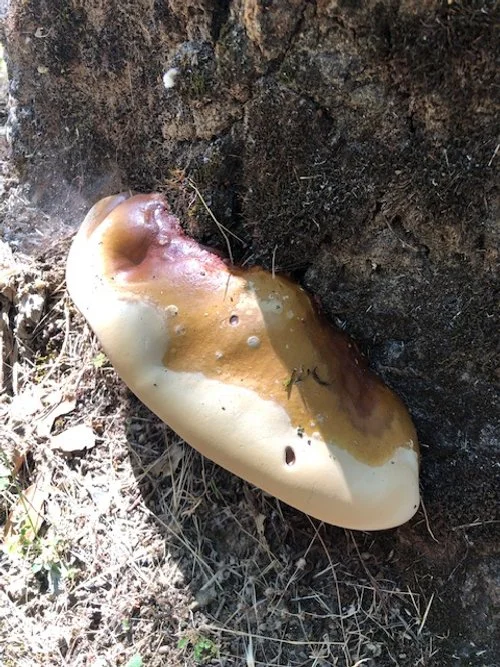Top 3 Mushroom Species on Oak trees in Eldorado County
In the Sierra Nevada foothills are home to 8 species in the genus Quercus. They are both emblematic of the area and a foundation species of native ecosystems. Mushrooms growing on trees are a big stumbling block for property owners who want to protect their old oaks. Often lack of knowledge leads to following bad advice (pouring concrete in cavities, spraying bleach on mushroom, or otherwise following old folk remedies which at best don’t work).
The first Step in a Sustainable Pest Management approach is understanding if the species you’re observing is causing any real issue, so here are common mushrooms which can impact structural integrity or tree health of oaks in the foothills.
1) Armillaria mellea group: This species is easily distinguished by its yellow-brown colored cap, with white-cream colored gills, whitish spores, annulus (ring around the stalk), fibrous stalk, and clustered (caespitose) growth habit. Found fruiting near the base or from the roots of Oaks or ornamental trees. The genus Armillaria as a whole has species on the pathogen spectrum, but the A. mellea group in California tends to be the most aggressive, it can grow in the cambial layers (which many wood decay fungi don’t) causing tree health decline and mortality. It is a white rot fungi, but tends to cause more tree health decline before causing structural integrity issues.
Armillaria mellea group enjoying a winter day at the bas of dead oak
Older A. mellea with annulus (ring) fading and darkened gills
2) Ganoderma polychromum: This is species is the group of red varnished reishi, so called because the color of the top. becomes red-orange with a shiny varnished appearance. The species is found fruiting near the base or from the roots of Oaks. This species can be identified by is sessile (no stalk) growth habit. It has pores on the underside of the cap, which are white when young and turn brown with age or when bruised. The top of the cap is pale when young, turning orange to red with age, having a shiny appearance. They often incorporate material they are growing close to, so its common to find grass, sticks, and leaves in the flesh of the fruiting body. The spores are brown and may accumulate on or around the fruiting body. This species has been documented as potentially being both a selective or simultaneous white rot fungi. This causes more structural integrity issues, which given the preferred placement in the tree, can cause uprooting or total tree failure. This species is one of the fungi that will attack oaks in summer in well watered areas as they grow well when temperatures are warmer.
young fresh Ganoderma polychromum at the base of a Quercus kelloggii
3) Laetiporus gilbertsonii: This polypore mushroom is brightly colored orange on top and yellow on the bottom, which explains it common name of Sulfur Shelf. This species is often a mushroom novices get right due to stand out appearance and it fruits before the first fall rains (august to october generally). So some simple basics of identifying this speices: they grow on oaks and eucalyptus mainly, the fruiting bodies have a shelf like habit with each shelf being 1-3 inches thick, Orange topside, yellow underside (fading to white with age), growing anywhere along the trunk of the tree. This species causes brown heart rot, which severely degrades the structural integrity of the wood it lives on. In my personal experience of 15+ documenting mushrooms in El Dorado county, this species is the most likely to led to structural failure of seemingly healthy trees. This is due to the fact that degrades the heartwood well, leaving hollow centers, which many trees can tolerate, but gets degrading into the sapwood until there is very little holding wood left.
Young fresh Laetiporus gilbertsonii, the orange colors top is still developing its color.
An old Valley Oak with failed in during an early autumn heatwave. The tree failed due to the extensive decay from L. gilbertsonii (this cross section was almost 4ft wide and was one of several stems). The Laetiporus is starting to form a fruiting body due to fresh exposure to oxygen.
These and many other fungal species play important roles in our native ecosystems. However, they can become a concern when they affect trees near homes, roads, powerlines, and other infrastructure. Fortunately, organic treatment options are available to help prevent many types of wood decay fungi from compromising tree health or structural integrity. If you have questions about your trees or mushrooms on your property in El Dorado, Sacramento, Placer, or Amador counties, feel free to reach out.




